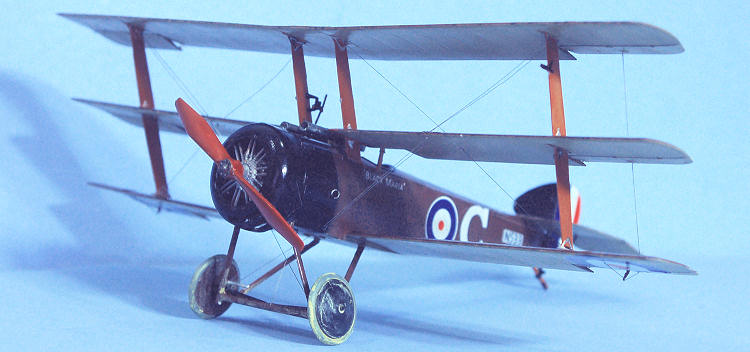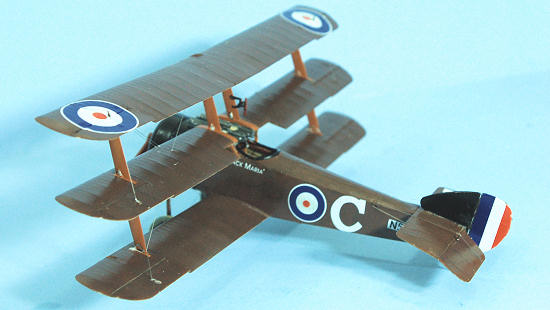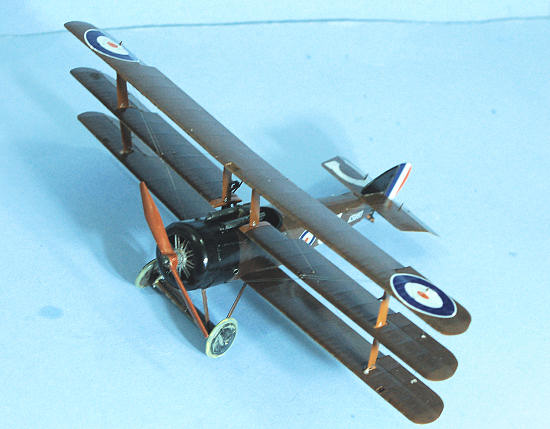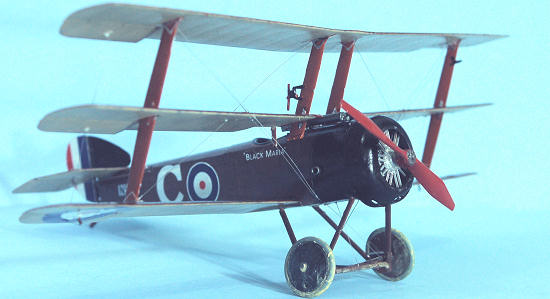
Roden 1/32 Sopwith Triplane
| KIT #: | 609 |
| PRICE: | $74.95 MSRP |
| DECALS: | Five options |
| REVIEWER: | Tom Cleaver |
| NOTES: |

| HISTORY |
The Sopwith Triplane ‑ known to its Royal Naval Air Service
pilots as the “Tripehound” ‑ was developed from the biplane Pup in late 1916.
The purpose of the triplane configuration was to
maximize pilot view with narrow‑chord wings and maximize maneuverability by
increasing wing area without increasing wingspan.
The result was a supremely maneuverable single‑seat
scout that had such a profound effect on its opponents that they paid it the
ultimate compliment of copying it ‑ directing all German aircraft manufacturers
to submit designs for triplane fighters within weeks of the appearance of the
Tripehound over the Western Front in the Spring of 1917.
The Triplane was generally about 15 m.p.h. faster than
the Albatros D.
Flown by such famous RNAS pilots as the Canadian Raymond
Collishaw,
American O.C. “Boots” LeBoutillier, and Englishman Reggie Soar,
the Sopwith Triplane went far to re‑establish British air superiority in the
northern region of the Western Front following the disaster of “Bloody April.”
Powered by the 110 h.p. Clerget engine, the fighter
suffered from a
 standard
armament of only one Vickers machine gun, though both Collishaw and Bob Little
flew a limited‑production series of Triplanes armed with two machine guns
despite the deleterious effect on performance from the extra weight of the
additional weapon.
standard
armament of only one Vickers machine gun, though both Collishaw and Bob Little
flew a limited‑production series of Triplanes armed with two machine guns
despite the deleterious effect on performance from the extra weight of the
additional weapon.
Such was the pace of technical development that the Triplane,
which first appeared at the Front in February and only achieved widespread
service in all four RNAS fighter squadrons ‑ Naval 1, naval 8, Naval 9 and Naval
10 ‑ by May, was considered obsolescent by late July and left front‑line service
by the end of August, 1917.
Replaced by the tricky Sopwith Camel, the Tripehound was
remembered by its pilots as a wonderful flying machine.
The Germans paid the Sopwith Triplane the honor of
copying it, with the better‑known Fokker Triplane being developed from a
requirement issued in direct response to the success of the Triplanes.
Unlike the Tripehound, which had ailerons on each wing,
the Dr.I only had ailerons on the upper wing, meaning the other two wings had to
be dragged through maneuvers.
The Sopwith could fly rings around Fokker's legendary
fighter.
Of course, by the time the Dr.I appeared, the air war had changed and
the airplane was essentially obsolete for air combat from its first day on the
front, though it would soldier on with the Fliegertruppen until May 1918, with a
few still flown by individual aces until the end of the war.
Raymond Collishaw:
Raymond Collishaw is recognized today as Canada's top ace of the
First World War, now that the claims of Billy Bishop have been shown to be
largely false.
Born and raised in Nanaimo, British Columbia, Collishaw joined
the Royal Naval Air Service in 1915 when the Royal Navy was too slow in
processing his application, traveling to England at his own expense to do so.
After undergoing flight training in England in the
winter and spring of 1916, in May 1916 he received his wings and was posted to 3
Naval Wing, which flew Sopwith 1½ Strutters as one‑seater bombers and two‑seater
fighters.
 Having established his fighting credentials with several
victories scored in the Strutter, Collishaw was posted to No. 3 Naval Squadron
in February, 1917. During the two months he was there, Collishaw flew as escort
to the RFC bombers stationed at Cambrai, adding an additional victory while so
doing. In April, 1917, he was transferred to No. 10 Naval Squadron, which had
just re-equipped with the new Sopwith Triplane.
Before the year was out, Raymond Collishaw would be one
of the leading Commonwealth aces as the leader of the famous Black Flight of
"Naval 10" squadron where he immortalized the “Tripehound.”
Having established his fighting credentials with several
victories scored in the Strutter, Collishaw was posted to No. 3 Naval Squadron
in February, 1917. During the two months he was there, Collishaw flew as escort
to the RFC bombers stationed at Cambrai, adding an additional victory while so
doing. In April, 1917, he was transferred to No. 10 Naval Squadron, which had
just re-equipped with the new Sopwith Triplane.
Before the year was out, Raymond Collishaw would be one
of the leading Commonwealth aces as the leader of the famous Black Flight of
"Naval 10" squadron where he immortalized the “Tripehound.”
No. 10 was posted back to Cambrai at the end of May,
where the Royal Flying Corps was in desperate need of reinforcements, much due
to the losses of Bloody April. Collishaw's "B" Flight was composed entirely of
Canadians.
The flight painted the noses of their aircraft and the wheel
covers black, gave each airplane a distinctive name, and went on to immortality
as “The Black Flight.” Ellis Reid, of Toronto, flew “Black Roger”; J. E.
Sharman, of
During combat in June and July, 1917, the Black Flight
claimed a record 87 German aircraft destroyed or driven
down; strangely enough, this feat brought the unit no publicity. Collishaw later
stated this was because the regular Royal Flying Corps didn't want to advertise
their desperate situation by giving credit to naval pilots.
On
Collishaw has generally been credited with shooting down
German ace Karl Allmenröder, who with 30 victories was
second to Richtofen in Jasta 11.
On
The four survivors of the Black Flight thought Nash was dead, and swore
to revenge themselves on Richtofen's Jasta. The next day, June 27, they came
across Jasta 11 over the front.
Collishaw got into a dogfight with the bright‑green
Albatros of Allmenröder. It was one of the classic dogfights of the war, like
Hawker against Richthofen.
The fight was a long one, two skilled and experienced
fighters who knew every trick in a battle to the death.
At last Collishaw found an opening, and sent a burst
into  Allmenröder,
who went down out of control, crashing to his death near
Allmenröder,
who went down out of control, crashing to his death near
Collishaw returned to
Collishaw returning in late November, 1917, and was
given command of No. 13 Naval Squadron, which was operating at the time from
Dunkirk, doing escort duty with the Channel Patrol.
By his own count, he
shot down 81 aircraft by the end of the war, which would make him the Ace of
Aces of the First World War.
The stringent RNAS scoring rules gave him a total of 60.
He was well-known for “giving” a victory to a new pilot who had flown with him,
to bolster the young man's confidence.
Recent research indicates that Collishaw's personal
tally can largely be supported by the evidence, which would indeed make him the
“Ace of Aces” of the Great War.
Collishaw remained in the Royal Air Force after the war,
and took 47 Squadron to
On
| THE KIT |
This kit by Roden is the first 1/32 injection molded kit
of the Sopwith Triplane, and may well be the only one, since Wingnut Wings has
announced a policy of not releasing a kit where there already is an accurate
model of the particular airplane in the scale.
The kit is produced in grey plastic, and provides a
basic cockpit, a detailed Clerget engine, and a choice of single-gun or twin-gun
armament.
The fabric detail is restrained and realistic in appearance.
Two different propellers are provided for the two
differing production versions of the airplane.
Only the late production horizontal stabilizer is
provided; Pheon is planning to do a resin early-production stabilizer.

Decals are provided for five Triplanes, including N5493
of Naval 8, flown by Robert Little, the Australian Ace of Aces; Collishaw's
“Black Maria” of Naval 10; “The Ooslumburd,” flown on home defense from Manston
in July 1917; the Triplane flown in French naval service by Charles Delesalle;
and the Triplane flown by General Marontov's cavalry during the Russian Civil
War.
Pheon Decals has also released sheets 32018, which
provides markings for every Sopwith Triplane flown by every RNAS ace of all four
squadrons, and 32019 which provides national markings for two Triplanes, one
with the white surround to the insignia and one without.
These are
excellent, well-researched decals, and well worth getting hold of if you are
going to do a Tripehound.
The Roden seat is a mere approximation of the wicker
seat used by RAF aircraft.
Fortunately, both Pheon and Lone Star Models have
released very good resin wicker seats, with the Lone Star seat having greater
detail with an “open” back.
The LSM seat retails for US$8, with a similar price for
the Pheon seat, which could be ordered when one gets the decal sheet.
I'd also like to put in a word of explanation here about
the price increase of Roden kits.
Two years ago, this kit would have sold for around
US$50, rather than the $74.95 it lists at.
This is due to the fact that in the last 18 months, the
Russian Government ended its agreement with Ukraine to provide oil and petroleum
products at previously-reduced prices following Ukraine's decision to adopt a
pro-Western, independent policy and become part of NATO, rather than remain
essentially part of Russia.
The result has been a 150% increase in the price of all
oil and petroleum-based products (like plastic) for domestic Ukrainian
companies.
This is not a case of Roden trying to gouge modelers.
HobbyLink Japan carries the kit with their 20% off
regular price, giving a
| CONSTRUCTION |
 Due to the relatively simple production design of the
kit, this model presents no problems for a modeler entering the World War I
genre.
Following the instructions, I had the basic assembly done in two days in
time outside of my “day job.”
I left the model in “sub-assemblies - the fuselage with
lower wing, engine and cowling, and tail surfaces - and the middle and upper
wings.
I posed the control surfaces in dynamic positions and made certain to
set the controls inside the cockpit correctly.
Due to the relatively simple production design of the
kit, this model presents no problems for a modeler entering the World War I
genre.
Following the instructions, I had the basic assembly done in two days in
time outside of my “day job.”
I left the model in “sub-assemblies - the fuselage with
lower wing, engine and cowling, and tail surfaces - and the middle and upper
wings.
I posed the control surfaces in dynamic positions and made certain to
set the controls inside the cockpit correctly.
I particularly liked the fuselage molding, since I was able to glue the upper rear fuselage with such good fit that I didn't have to sand down the seams in such a way that the turtleback detail would be lost.
| COLORS & MARKINGS |
The Pheon markings profiles show Collishaw's airplane in
“classic” P.C.10 green-base camouflage.
However, P.C.10 came in shades ranging from medium green
to chocolate brown, depending on manufacturer.
Eduard's “Black Flight” release
 of 1994
showed a brown-base color on the airplane, and I decided since so many of my
British airplanes have the green-base color that I would paint this model in a
brown-base color, just for a difference.
When one produces a color photo of Collishaw's airplane,
we will know for sure what color it was, but for now any dark color is as good
as any other, leaving it to the choice of the modeler.
of 1994
showed a brown-base color on the airplane, and I decided since so many of my
British airplanes have the green-base color that I would paint this model in a
brown-base color, just for a difference.
When one produces a color photo of Collishaw's airplane,
we will know for sure what color it was, but for now any dark color is as good
as any other, leaving it to the choice of the modeler.
| FINAL CONSTRUCTION |
| CONCLUSIONS |

Decals courtesy Pheon Decals.
January 2011
If you would like your product reviewed fairly and quickly, please contact me or see other details in the Note to Contributors.